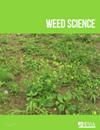Effect of Osmotic Potential and Temperature on Germination of Kochia (Bassia scoparia) Populations from the U.S. Great Plains
IF 2.1
2区 农林科学
Q2 AGRONOMY
引用次数: 0
Abstract
Abstract Development of integrated weed management strategies requires knowledge of weed emergence timing and patterns, which are regulated primarily by water and thermal requirements for seed germination. Laboratory experiments were conducted in fall 2017 to fall 2018 to quantify the effect of osmotic potential and temperature on germination of 44 kochia [Bassia scoparia (L.) A.J. Scott] populations under controlled conditions. Bassia scoparia populations were collected in fall 2016 from northern (near Huntley, MT, and Powell, WY) and southern (near Lingle, WY, and Scottsbluff, NE) regions of the U.S. Great Plains. Ten osmotic potentials from 0 to –2.1 MPa and eight constant temperatures from 4 to 26 C were evaluated. Response of B. scoparia populations to osmotic potential did not differ between the northern and southern regions. At an osmotic potential of 0 MPa, all B. scoparia populations had greater than 98% germination, and the time to achieve 50% germination (t50) was less than 1 d. At –1.6 MPa, 25% of seeds of all B. scoparia populations germinated. Osmotic potentials of –0.85 and –1.9 MPa reduced B. scoparia germination by 10% and 90%, respectively. Regardless of temperature regime, all populations exhibited greater than 88% germination. The germination rate was highest at temperatures between 15 to 26 C and did not differ between populations from northern versus southern regions. At this temperature range, all populations had a t50 of less than 1 d. However, at 4 C, B. scoparia populations from the northern region had a higher germination rate (5 h) and cumulative germination (7%) than populations from the southern region. Overall, these results indicate a wide range of optimum temperatures and osmotic potential requirements for B. scoparia germination.渗透势和温度对美国大平原地瓜(Bassia scoparia)种群发芽的影响
摘要制定综合杂草管理策略需要了解杂草出现的时间和模式,这主要受种子发芽的水和热需求的调节。在2017年秋季至2018年秋季进行了实验室实验,以量化渗透势和温度在受控条件下对44个曲【Bassia scoparia(L.)A.J.Scott】种群发芽的影响。2016年秋季,在美国大平原的北部(MT Huntley和WY Powell附近)和南部(WY Lingle和NE Scottsbluf附近)采集到了东亚巴西利亚种群。评估了0至-2.1 MPa的10个渗透势和4至26 C的8个恒定温度。南、北两个地区的东莨菪种群对渗透势的反应没有差异。在0 MPa的渗透势下,所有东莨菪种群的发芽率均大于98%,达到50%发芽率的时间(t50)小于1 d。在-1.6 MPa下,所有西莨菪群落25%的种子发芽。–0.85和–1.9 MPa的渗透电位分别使东莨菪的发芽率降低了10%和90%。无论温度如何,所有种群都表现出超过88%的发芽率。发芽率在15至26摄氏度的温度下最高,北部和南部地区的种群之间没有差异。在这个温度范围内,所有种群的t50都小于1d。然而,在4℃时,来自北部地区的东莨菪种群的发芽率(5小时)和累积发芽率(7%)高于来自南部地区的种群。总的来说,这些结果表明,对B.scoparia发芽来说,最适温度和渗透势要求范围很广。
本文章由计算机程序翻译,如有差异,请以英文原文为准。
求助全文
约1分钟内获得全文
求助全文
来源期刊

Weed Science
农林科学-农艺学
CiteScore
4.60
自引率
12.00%
发文量
64
审稿时长
12-24 weeks
期刊介绍:
Weed Science publishes original research and scholarship in the form of peer-reviewed articles focused on fundamental research directly related to all aspects of weed science in agricultural systems. Topics for Weed Science include:
- the biology and ecology of weeds in agricultural, forestry, aquatic, turf, recreational, rights-of-way and other settings, genetics of weeds
- herbicide resistance, chemistry, biochemistry, physiology and molecular action of herbicides and plant growth regulators used to manage undesirable vegetation
- ecology of cropping and other agricultural systems as they relate to weed management
- biological and ecological aspects of weed control tools including biological agents, and herbicide resistant crops
- effect of weed management on soil, air and water.
 求助内容:
求助内容: 应助结果提醒方式:
应助结果提醒方式:


